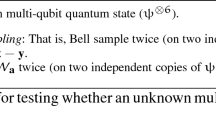Abstract
A few years ago, Blais, Brody, and Matulef: Comput. Complex. 21(2), 311–358 (2012) presented a methodology for proving lower bounds for property testing problems by reducing them from problems in communication complexity. Recently, Bhrushundi, Chakraborty, and Kulkarni (2014) showed that some reductions of this type can be deconstructed to two separate reductions, from communication complexity to randomized parity decision trees and from the latter to property testing. This work follows up on these ideas. We introduce a model called linear-access algorithms, which is a generalization of randomized parity decision trees, and show several methods to reduce communication complexity problems to problems for linear-access algorithms and problems for linear-access algorithms to property testing problems. This approach yields a new interpretation for several well-known reductions, since we present these reductions as a composition of two steps with fundamentally different functionalities. Furthermore, we demonstrate the potential of proving lower bounds on property testing problems by reducing them directly from problems for linear-access algorithms. In particular, we provide an alternative and simple proof for a known lower bound of Ω(k) queries on testing “k-linearity”; that is, the property of k-sparse linear functions over \(\mathbb {F}_{2}\). This alternative proof relies on a theorem by Linial and Samorodnitsky: Combinatorica 22(4), 497–522 (2002). We then extend this result to a new lower bound of Ω(s) queries for testing s-sparse degree-d polynomials over \(\mathbb {F}_{2}\), for any \(d\in \mathbb {N}\). In addition we provide a simple proof for the hardness of testing some families of linear subcodes.
Similar content being viewed by others
Notes
The equivalence of linear-access algorithms over \(\mathbb {F}=\mathbb {F}_{2}\) and randomized parity decision trees depends on the definition of the latter. Specifically, randomized parity decision trees are sometimes defined as arbitrary distributions over parity decision trees (cf., e.g., [2]), whereas we define linear-access algorithms as randomized oracle machines (see Definition 2.5). A gap between the models exists when considering distributions over parity decision trees that cannot be computed by randomized oracle machines.
The exact complexity of the problem is Ω(min{k,n − k}); see Section 5.4 for further details
Regarding upper bounds for \({\mathcal {P}}\), to obtain a tester for \({\mathcal {P}}\) from an existing tester for π one can add a linearity test [5] and use self-correction (see, e.g., [2, Appendix A] for details). However, self-correction may increase the tester’s query complexity by a logarithmic multiplicative factor.
Note that one might expect a lower bound of \({\Omega }(\min \{s,\binom {n+d}{d}-s\})\) for this property, since n-variate degree-d polynomials have \(\binom {n+d}{d}\) coefficients. However, since for a fixed \(d\in \mathbb {N}\) it holds that both \(\binom {n+d}{d}\) and \(\binom {n}{d}\) are Θ(nd), the difference between such a lower bound and the one presented in Theorem 5.9 is not significant.
References
Bhattacharyya, A., Fischer, E., Hatami, H., Hatami, P., Lovett, S.: Every Locally Characterized Affine-Invariant Property is Testable. In: Proceedings of the Forty-fifth Annual ACM Symposium on Theory of Computing, STOC ’13, pp 429–436. ACM, New York (2013)
Bhrushundi, A., Chakraborty, S., Kulkarni, R.: Property testing bounds for linear and quadratic functions via parity decision trees. In: CSR, pp. 97–110 (2014)
Blais, E., Brody, J., Matulef, K.: Property testing lower bounds via communication complexity. Comput. Complex. 21(2), 311–358 (2012)
Blais, E., Kane, D.M.: Tight bounds for testing k-linearity. In: APPROX-RANDOM, pp. 435–446 (2012)
Blum, M., Luby, M., Rubinfeld, R.: Self-testing/correcting with Applications to Numerical Problems. In: Proceedings of the Twenty-second Annual ACM Symposium on Theory of Computing, STOC ’90, pp 73–83. ACM, New York (1990)
Buhrman, H., García-soriano, D., Matsliah, A., de Wolf, R.: The non-adaptive query complexity of testing k-parities. Chicago Journal of Theoretical Computer Science (2013)
Chor, B., Goldreich, O.: Unbiased bits from sources of weak randomness and probabilistic communication complexity (extended abstract). In: FOCS, pp. 429–442 (1985)
Cohen, G., Shinkar, I.: The complexity of dnf of parities. Electron. Colloq. Comput. Complex. (ECCC) 21, 99 (2014)
Goldreich, O.: On testing computability by small width obdds. In: APPROX-RANDOM, pp. 574–587 (2010)
Goldreich, O.: On the communication complexity methodology for proving lower bounds on the query complexity of property testing. Electron. Colloq. Comput. Complex. (ECCC) 20, 73 (2013)
Goldreich, O.: Introduction to Property Testing (working draft), April 26, 2017. Accessed at http://www.wisdom.weizmann.ac.il/oded/pt-intro.html, May 15, 2017
Håstad, J., Wigderson, A.: The randomized communication complexity of set disjointness. Theory Comput. 3(11), 211–219 (2007)
Klauck, H.: Rectangle size bounds and threshold covers in communication complexity. In: IEEE Conference on Computational Complexity, pp. 118–134 (2003)
Kushilevitz, E., Nisan, N.: Communication complexity. Cambridge University Press, Cambridge (1997)
Linial, N., Samorodnitsky, A.: Linear codes and character sums. Combinatorica 22(4), 497–522 (2002)
Montanaro, A., Osborne, T.: On the communication complexity of xor functions. CoRR, arXiv:0909.3392 (2009)
Razborov, A.A.: on the distributional complexity of disjointness. In: ICALP, pp. 249–253 (1990)
Shaltiel, R.: An introduction to randomness extractors. In: ICALP (2), pp. 21–41 (2011)
Shpilka, A., Tal, A., Volk, B.L.: On the structure of boolean functions with small spectral norm. In: ITCS, pp. 37–48 (2014)
Tell, R.: An alternative proof of an Ω(k) lower bound for testing k-linear boolean functions. Electron. Colloq. Comput. Complex. (ECCC) 21, 73 (2014)
Zhang, Z., Shi, Y.: On the parity complexity measures of boolean functions. Theor. Comput. Sci. 411(26-28), 2612–2618 (2010)
Acknowledgments
The author thanks Tom Gur for suggesting the initial observation motivating the study and for several helpful discussions during the research process. The author is grateful to Avishay Tal for pointing him to the work of Linial and Samorodnitsky. The author also thanks his advisor, Oded Goldreich, for his guidance and support in the research and writing process. This research was partially supported by the Israel Science Foundation (grant No. 671/13).
Author information
Authors and Affiliations
Corresponding author
Additional information
Publisher’s Note
Springer Nature remains neutral with regard to jurisdictional claims in published maps and institutional affiliations.
Rights and permissions
About this article
Cite this article
Tell, R. Property Testing Lower Bounds via a Generalization of Randomized Parity Decision Trees. Theory Comput Syst 63, 418–449 (2019). https://doi.org/10.1007/s00224-018-9880-3
Published:
Issue Date:
DOI: https://doi.org/10.1007/s00224-018-9880-3




